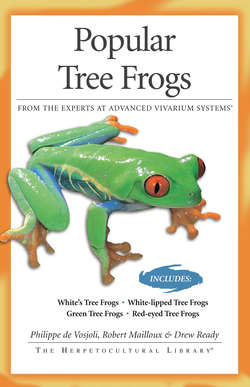Читать книгу Popular Tree Frogs - Robert Mailloux - Страница 7
На сайте Литреса книга снята с продажи.
ОглавлениеCHAPTER 3
TEMPERATURE AND HUMIDITY
Heating
Most tree frogs do not bask in sunlight like other reptiles, although several species appear to enjoy basking, usually in the later part of the day. Because of this, basking lights are not a good way to heat tree frog enclosures. In general, frogs should be kept in rooms that are in the range of their temperature tolerance. Room temperatures in the mid 70s °F are suitable for most tree frogs, although certain montane and cool-climate species require colder temperatures. Once the temperature in the room is in the general range of your tree frogs’ requirements, you can provide supplemental heat by using subtank heating strips controlled by a rheostat, similar to electronic light dimmers, or thermostat, or by placing submersible heaters in the water section adjusted to keep the water in the correct temperature range. Some herpetoculturists place submersible heaters in large jars of water or put 25-watt red incandescent bulbs over select areas. If controlled by a rheostat or pulse-proportional thermostat, low-wattage infrared ceramic bulbs also work in large enclosures. In the authors’ opinion, the best choice is to keep your frogs in a room that is heated to their temperature requirements and not to supply additional heating.
Two color variations of the barking tree frog.
Cooling
Few tree frogs currently collected or imported for the pet trade require unusually cool temperatures. If you decide to keep cool-temperature or montane species, use a thermostat-controlled air conditioner to keep the room cool. During emergencies or heat waves, place jars of ice in the vivarium and cover it with Styrofoam to prevent it from overheating. In dry climates, “swamp coolers” (evaporative coolers) may be adequate for lowering room temperature to a satisfactory level.
Relative Humidity
Proper relative humidity is critical to the successful maintenance and breeding of frogs. Most frogs thrive in 60 to 70 percent moderate relative humidity (use a hygrometer to measure relative humidity). This level is easily maintained in naturalistic vivaria or vivaria with hydroponic plants. If necessary, use a cool-air humidifier to raise the relative humidity of a room. Lightly misting a vivarium one or more times each day will also increase relative humidity. In an unventilated area, saturated humidity levels are fatal to most tree frogs; never keep tree frogs in glass covered vivaria.
You can condition many tropical tree frogs for breeding by keeping them at a lower relative humidity for a few weeks or months, thereby simulating a dry season. During this conditioning, do not mist the enclosure, to keep the frogs drier, but leave a water container as the primary source of moisture.
